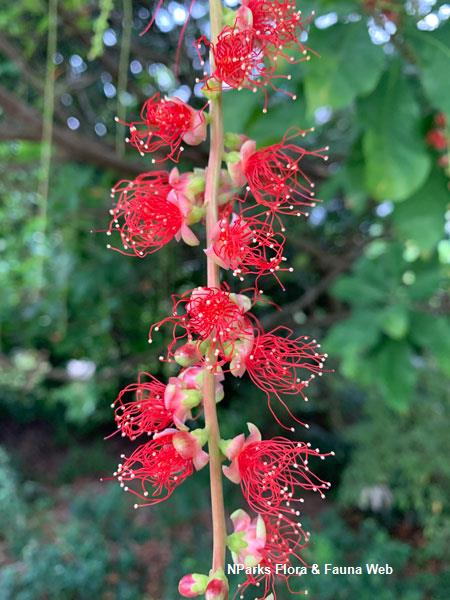
Name
Classifications and Characteristics
| Plant Division | Angiosperms (Flowering Seed Plants) |
|---|---|
| Plant Growth Form | Tree |
| Maximum Height | 4.5 m |
Biogeography
| Native Distribution | Myanmar, Sumatra, Peninsular Malaysia, Singapore, Bangka Island, and Borneo |
|---|---|
| Native Habitat | Terrestrial |
| Preferred Climate Zone | Tropical |
| Local Conservation Status | Native to Singapore (Presumed Nationally Extinct (NEx)) |
Description and Ethnobotany
| Growth Form | It is an erect branched shrub or small tree about 3.6–4.5 m tall. |
|---|---|
| Foliage | Its stalked leaves have thickly membranous leaf blades that are oblong-lance-shaped and 11.3–25 by 5–10 cm, with 9–15 pairs of veins. |
| Flowers | Its flowers are 2.5 by 2.5 cm. Its petals are white and fleshy. |
| Fruit | Its fruits are green, cone-shaped, and 6.3 by 3.1 cm. |
| Habitat | It grows in tidal mud by rivers and mangrove swamps. |
| Associated Fauna | Its flowers are mammal-pollinated. |
| Cultivation | It can be propagated by seed. |
| Etymology | Latin Barringtonia, commemorating Daines Barrington (1727–1800), a British naturalist; Greek conoidea, cone-like, referring to the fruit of this species |
Landscaping Features
| Landscape Uses | Parks & Gardens, Marsh / Bog |
|---|
Fauna, Pollination and Dispersal
| Pollination Method(s) | Biotic (Fauna) |
|---|
Plant Care and Propagation
| Light Preference | Full Sun, Semi-Shade |
|---|---|
| Water Preference | Lots of Water, Moderate Water |
| Plant Growth Rate | Moderate |
| Rootzone Tolerance | Moist Soils, Waterlogged Soils |
Foliar
| Mature Foliage Colour(s) | Green |
|---|
Floral (Angiosperm)
| Flower Colour(s) | Cream / Off-White |
|---|
References
| References | Corner, E.J.H. 1988. Wayside Trees of Malaya Volume 1 & 2. Kuala Lumpur, Malaysia: The Malayan Nature Society. 861 Ridley, H. N.. 1922. The Flora of the Malay Peninsula. Volume 1. London: L. Reeve & Co., Ltd. 918 |
|---|
Image Repository
Others
| Master ID | 29294 |
|---|---|
| Species ID | 3603 |
| Flora Disclaimer | The information in this website has been compiled from reliable sources, such as reference works on medicinal plants. It is not a substitute for medical advice or treatment and NParks does not purport to provide any medical advice. Readers should always consult his/her physician before using or consuming a plant for medicinal purposes. |


_lowres.jpg)


_lowres.jpg)